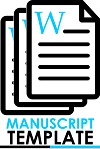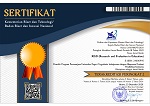Exploring problem-solving competence in Indonesian language learning: An EFA study using ecological image stimuli
DOI:
https://doi.org/10.21831/reid.v11i1.85466Keywords:
construct validity, problem solving, opinions, exploratory factor analysis (EFA)Abstract
The necessity of problem-solving skills has become a core competency that university students must possess, particularly through the appropriate and accurate use of the Indonesian language. This study aims to construct a theoretical framework of problem-solving abilities by analyzing the composition of opinion texts in Indonesian language learning. The research employs Polya’s theoretical approach, integrated with recent studies, and utilizes a quantitative methodology through Exploratory Factor Analysis (EFA). This method is used to examine the validity of the theoretical construction of problem-solving skills within the context of writing opinion texts in Indonesian language learning. The problem-solving theory derived from opinion-based learning was developed to produce a valid measurement instrument. The study began with the development of indicators drawn from various studies on problem-solving competencies. The resulting instrument consists of 19 items administered to students from both science and social studies tracks. A total of 298 first-semester students from Central Java participated in this study. The test reliability estimation yields a standardized alpha of 0.71. The findings include: (1) the adequacy of the sample was confirmed with a KMO-MSA value > 0.5, specifically 0.71, and a significance level of 0.001 on the Bartlett’s test; (2) all items were found to measure problem-solving skills, indicated by anti-image correlation values > 0.5; and (3) the study identified four dimensions of problem-solving skills based on opinion text analysis: initial problem identification, problem resolution, taking tangible action, and evaluation of implemented solutions solution reflection.
References
Adas, D., & Bakir, A. (2013). Writing difficulties and new solutions: Blended learning as an approach to improve writing abilities. International Journal of Humanities and Social Science, 3(9), 254–266. https://www.ijhssnet.com/journal/index/1819
Albaburrahim, A., & Amin, M. B. (2024). Analisis pendekatan ekologi dalam pembelajaran bahasa Indonesia di era digital. GHANCARAN: Jurnal Pendidikan Bahasa dan Sastra Indonesia, 671–683. https://doi.org/10.19105/ghancaran.vi.17930
Errington, A., & Bubna-Litic, D. (2015). Management by textbook: The role of textbooks in developing critical thinking. Journal of Management Education, 39(6), 774–800. https://doi.org/10.1177/1052562915594839
Fisher, A. (2011). Critical thinking: An introduction. Cambridge University Press.
Flavell, J. (1979). Theories of learning in educational psychology. American Psychologist, 34, 906–911.
Hambleton, R., & Patsula, L. (1998). Adapting tests for use in multiple languages and cultures. Social Indicators Research, 45, 153–171. https://doi.org/10.1023/A:1006941729637
Hartati, D., Kurniasih, K., & Karim, A. A. (2023). Kajian ekologi sastra dalam kumpulan cerpen tentang desir karya Gladhys Elliona. Jurnalistrendi: Jurnal Linguistik, Sastra dan Pendidikan, 8(1), 20–30. https://doi.org/10.51673/jurnalistrendi.v8i1.1471
Hayes, J. R., & Flower, L. S. (1980). Writing as problem solving. Visible Language, 14(4), 388-399. https://journals.uc.edu/index.php/vl/article/view/5308
Hayes, J. R., & Flower, L. S. (1986). Writing research and the writer. American Psychologist, 41(10), 1106. https://doi.org/10.1037/0003-066X.41.10.1106
Jefiza, I., Widodo, P., & Sudartinah, T. (2025). Muatan ekologi dalam bahan literasi sekolah dasar pada website Kemendikbud: Analisis korpus. Indonesian Language Education and Literature, 10(2), 270–292. https://doi.org/10.24235/ileal.v10i2.17701
King, F. J., Goodson, L., & Rohani, F. (1998). Higher order thinking skills: Definition, teaching strategies, assessment. Center for the Advancement of Learning and Assessment, Florida State University.
Lamberg, W. J. (1977). Major problems in doing academic writing. College Composition & Communication, 28(1), 26–29. https://doi.org/10.2307/356889
Lowyck, J., & Pöysä, J. (2001). Design of collaborative learning environments. Computers in Human Behavior, 17, 507–516. https://doi.org/10.1016/S0747-5632(01)00017-6
Lubezky, A., Dori, Y. J., & Zoller, U. (2004). HOCS-promoting assessment of student’s performance on environment-related undergraduate chemistry. Chemistry Education Research and Practice, 5(2), 175–184. https://doi.org/10.1039/B4RP90019G
Mualimin, M., & Pamungkas, R. (2024). Holistic higher-order thinking in solving environmental problems: A profile of Indonesian undergraduate students. Journal of Biological Education Indonesia (Jurnal Pendidikan Biologi Indonesia), 10(3), 804–812. https://doi.org/10.22219/jpbi.v10i3.36426
Olson, C. B. (1992). Thinking/writing: Fostering critical thinking through writing. Harper Collins Publisher.
Oradee, T. (2013). Developing speaking skills using three communicative activities (Discussion, problem-solving, and role-playing). International Journal of Social Science and Humanity, 2(6), 533-535. https://doi.org/10.7763/ijssh.2012.v2.164
Reed, M. S. (2008). Stakeholder participation for environmental management: A literature review. Biological Conservation, 141(10), 2417–2431. https://doi.org/10.1016/j.biocon.2008.07.014
Reina, L., & Clark, S. K. (2019). Teaching students to write opinion pieces using a dialogic approach. The Reading Teacher, 73(3), 357–361. https://doi.org/10.1002/trtr.1848
Ruddell, R. M. (2005). Teaching content reading and writing. Hermitage Publishing Services.
Samsiyah, N. (2024). Pembelajaran bahasa Indonesia bermuatan ecopedagogis untuk meningkatkan kecerdasan ekologis. GHANCARAN: Jurnal Pendidikan Bahasa dan Sastra Indonesia, 115–124. https://doi.org/10.19105/ghancaran.vi.17192
Santos-Trigo, M. (2024). Problem solving in mathematics education: Tracing its foundations and current research-practice trends. ZDM–Mathematics Education, 56(2), 211–222. https://doi.org/10.1007/s11858-024-01578-8
Saputri, N. D., Suwandi, S., & Wardani, N. E. (2025). Nilai kecerdasan ekologis dalam buku ajar bahasa Indonesia berbasis Kurikulum Merdeka di SMP Yogyakarta. Jurnal Genre (Bahasa, Sastra, dan Pembelajarannya), 7(1), 67–81. https://doi.org/10.26555/jg.v7i1.12341
Shi, Y., & Iordanou, K. (2025). A dialogic approach to enhancing argumentative writing from multiple texts. ECNU Review of Education, 8(2), 530-556. https://doi.org/10.1177/20965311241310884
Shokri, M. A., & Mousavi, K. (2024). Enhancing writing pedagogy: An exploration of metacognitive awareness raising strategies on creativity and critical thinking in writing courses. Bayan College International Journal of Multidisciplinary Research, 4(1), 11–42. http://www.bayancollegeijmr.com/index.php/ijmr/article/view/148
Snyder, L. G., & Snyder, M. J. (2008). Teaching critical thinking and problem solving skills. The Journal of Research in Business Education, 50(2), 90-99. https://hochbegabung.education/wp-content/uploads/2025/01/Optional-_Teaching-Critical-Thinking-and-Problem-Solving-Skills.pdf
Sudaryanto, M., Saddhono, K., Wahyono, H., Widiatmi, T., Ino, L., Hidayat, H., Wirajaya, A., Suhardi, I., Waluyo, B., & Pramono, P. (2019). Indonesian as a foreign language: Standard setting and materials development issues. 1st Workshop on Environmental Science, Society, and Technology, WESTECH, 178–184. https://doi.org/10.4108/eai.8-12-2018.2284065
Sudaryanto, M., Ulya, C., Rohmadi, M., & Wulansari, K. (2020). Learning trajectory: Reactions of prospective teachers looking for solutions to learning problems. B-SPACE 2019: Proceedings of the First Brawijaya International Conference on Social and Political Sciences, BSPACE, 26-28 November, 2019, Malang, East Java, Indonesia, 7. http://dx.doi.org/10.4108/eai.26-11-2019.2295220
Suwandi, S., Sudaryanto, M., Wardani, N. E., Zulianto, S., Ulya, C., & Setiyoningsih, T. (2021). Keterampilan berpikir tingkat tinggi dalam soal ujian nasional bahasa Indonesia. Jurnal Kependidikan: Penelitian Inovasi Pembelajaran, 5(1), 31-44. https://doi.org/10.21831/jk.v5i1.35457
Villamor, G. B., Palomo, I., Santiago, C. A. L., Oteros-Rozas, E., & Hill, J. (2014). Assessing stakeholders’ perceptions and values towards social-ecological systems using participatory methods. Ecological Processes, 3, 22. https://doi.org/10.1186/s13717-014-0022-9
White, E. M. (1994). Issues and problems in writing assessment. Assessing Writing, 1(1), 11–27. https://doi.org/10.1016/1075-2935(94)90003-5
Yuxian, J. (2025). Bridging the knowledge-skill gap: The role of large language model and critical thinking in education. Computers & Education, 235, 105357. https://doi.org/10.1016/j.compedu.2025.105357
Zitha, I., Lambani, M. N., & Bvuma, V. (2023). Register competence in academic writing: A case study of third-level English students at the University of Venda, Limpopo Province. Master's Thesis, University of Venda, South Africa. https://univendspace.univen.ac.za/server/api/core/bitstreams/095b4a1d-2bb2-4aae-a2db-2a886872c4c4/content
Zuber-Skerritt, O., & Knight, N. (1986). Problem definition and thesis writing: Workshops for the postgraduate student. Higher Education, 15(1), 89–103. https://www.jstor.org/stable/3446744
Downloads
Published
How to Cite
Issue
Section
Citation Check
License
Copyright (c) 2025 REID (Research and Evaluation in Education)

This work is licensed under a Creative Commons Attribution-ShareAlike 4.0 International License.
The authors submitting a manuscript to this journal agree that, if accepted for publication, copyright publishing of the submission shall be assigned to REID (Research and Evaluation in Education). However, even though the journal asks for a copyright transfer, the authors retain (or are granted back) significant scholarly rights.
The copyright transfer agreement form can be downloaded here: [REID Copyright Transfer Agreement Form]
The copyright form should be signed originally and sent to the Editorial Office through email to reid.ppsuny@uny.ac.id

REID (Research and Evaluation in Education) by http://journal.uny.ac.id/index.php/reid is licensed under a Creative Commons Attribution-ShareAlike 4.0 International License.







.png)





